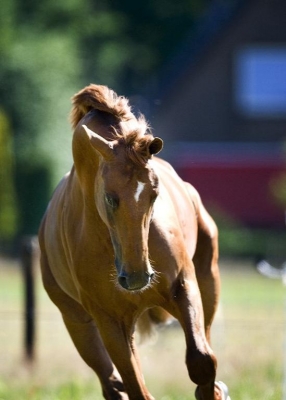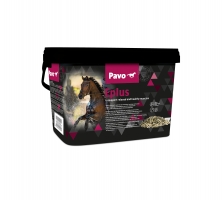|
Advice article filter
|
Vitamin E and selenium for horses: To feed it or not?Why are vitamin E and selenium important for horses?Waste materials are released in every form of work; just as a car produces exhaust gases when burning fuel, a muscle produces waste products when working. With a horse, it is important that these waste products are properly disposed of and that the muscles can also rebuild themselves. The waste products that a muscle produces are called free radicals, of which there are three kinds:
These waste products are rendered harmless in the muscle because vitamin E and selenium ‘neutralize’ them. Vitamin E and selenium are antioxidants, substances that, by cleaning up waste materials, prevent muscle damage after working. Another antioxidant is vitamin C. These three antioxidants work together and in the right proportion more efficient than on their own. Pavo Eplus contains all these antioxidants in the correct proportions. Natural and synthetic vitamin EIn addition to sustaining muscles, vitamin E also plays a supporting a role in the nervous system and immune system. There are two variants of vitamin E on the market: a natural (d-alpha-tocopherol) and a synthetic (dl-alpha-tocopherol). Natural vitamin E is better absorbed by the horses’ body than the synthetic type. The supplement Pavo Eplus contains the natural variant of vitamin E, obtained from vegetable matter. How much vitamin E does a horse need?Your horse needs a fair amount of vitamin E. According to the National Research Council, the basic need of an adult horse is 500 mg of vitamin E per day. For a horse doing light work this goes up to 800mg per days and for heavy labour it is even 1000mg per day. Therefore, the vitamin E requirement depends on the degree of labour. The heavier the work, the more vitamin E required. Additionally, the amount of fat in a horses feed plays a role. Meaning, the more fat in the feed, the greater the need for vitamin E. Your horse can get the majority of its vitamin E requirement from grass. If your horse is in the field enough, and eats grass there, then it gets more than the its basic requirements already. When you horse does not get enough grass, there is a chance of a vitamin E deficiency. Vitamin E has difficulty keeping stable when it gets warm. So, when you store hay and silage, the vitamin E content decreases. Therefore, it may be that your horse needs an extra supplement. Daily amount of SeleniumHorses only needs a small amount of selenium. An adult horse has a selenium requirement of 0.2 mg per 100 kg body weight. Selenium is a trace element that is nothing other than a mineral of which only a small amount is needed. The trouble with selenium is that that the difference between the optimal amount and too much is very small. You only need to give a little bit too much and it is no longer healthy for your horse. So, be careful! The chance of a selenium deficiency from a roughage diet is more likely. This is because in many places in the Netherlands, soil has a low selenium content. Vitamin E and selenium deficiencyThe symptoms of a vitamin E deficiency are muscle damage and yellow fat disease. A shortage of selenium not only causes muscle problems and yellow fat disease but also a low immune system. Due to a shortage of these antioxidants free radicals are not neutralised and damage can occur in the cell. The ageing process is a good example of this. You can identify if you horse has muscle damage by muscle pain, stiffness and if your horse takes too long to recover after an intense workout. If you are unsure whether your horse is predisposed to muscle acidification after hard labour, you can give the Pavo Eplus supplement preventively to support the muscles. Horses that are known to have stiffness and muscle pain after exercise, benefit more from Pavo MuscleCare. Too much vitamin E and seleniumA surplus of vitamin E is toxic for your horse. Due to the fact that vitamin E plays a role in the production of red blood cells, an important symptom of too much vitamin E is the occurrence of spontaneous bleeding. For this reason, there is a prescribed maximum daily dose of 400 mg per 100 kg body weight. Unfortunately, a horse cannot easily excrete a surplus of selenium. An excess of, for example, salt or protein is excreted by the kidneys and then leaves the body through urination. That process does not work for selenium. When a horse has too much selenium in its body, it will store it somewhere where it will eventually disappear: such as in the hooves, tail and/or mane. In these places, selenium cannot cause damage to the organs, but it does not belong there. In some instances, hair loss and brittle hooves can occur. That is why it is important that you give your horse enough selenium to care for its muscles, but be careful not to give too much, because it is not healthy. Selenium poisoning symptoms may occur with a daily dose of more than 4 to 5 mg per 100kg of body weight. So always follow the feed advice from Pavo Eplus to avoid overdosing! Conclusion: Should you give a vitamin E and selenium supplement or not?In a nutshell: first take a critical look at the basic diet of your horse before you add a supplement. The training schedule must also be viewed with a critical eye. Does your horse stay stiff for a little too long after training? Then Pavo Eplus is the supplement your horse needs for supple muscles and to optimally support muscle function. |




